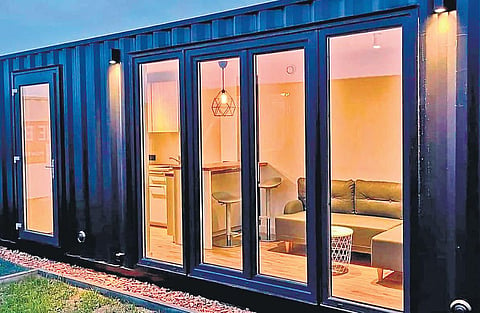

While the tiny house movement is taking the West by storm, architects in Hyderabad say we are looking at our own version of the movement. More and more millennials, out of financial constraints, are choosing co-living spaces over individual houses, apartments over villas and rented places over owned houses.
HYDERABAD: Back in the 2010s, young folks in the West started ditching the big-house dream for a more financial and ecologically sustainable way of living, by choosing to live in smaller, compact and even mobile houses with minimum resources. The rationale was to address environmental concerns, financial concerns and the desire for more time and freedom.
India is yet to witness its wave of this movement in its strict sense. Experts say that we are looking at our own version of the tiny house movement where more and more millennials, out of financial constraints, are choosing co-living spaces over individual houses, apartments over villas and rented places over owned houses.
City-based architect G Shankar Narayan says the tiny house movement is an eco-conscious movement in the West but “we may not be able to literally apply the same thing to the Indian condition.”
A burgeoning population, ever-reducing space in cities, sky-rocketing real estate prices, coupled with migration and inflation is contributing to a palpable movement where people are forced to live in tiny spaces, not out of choice, but necessity. “Why would someone want to live in co-living spaces, if not to share resources and save money? The middle-class even today lives in smaller houses not out of choice but out of compulsion because they cannot afford big homes,” says Shankar.
Between 2014 and 2018, the average apartment size in seven major Indian cities shrunk by 17 per cent, according to a study done by ANAROCK Property Consultants. At 27 per cent, Mumbai saw the highest decrease in apartment size, while Bengaluru saw the lowest (12 per cent). In 2020, however, the average apartment size in Hyderabad was at 1,750 sq ft, the highest compared to other cities, and almost two times bigger than Mumbai, where, at 932 sq ft, it was the lowest. “After Covid, there’s a ‘bigger-house’ movement also. People who can afford are upgrading from their present accommodation. With work-from-home and online classes, people decided to go for bigger homes,” says Shankar.
The tiny house movement in the West runs into a lot of problems, says the architect. Issues such as getting permits to build the house and leasing land, building recreational trailer parks for mobile homes, also known as house-on-wheels, to dump their waste, and charge their appliances are all part of the parcel. However, Shankar says there are other ways of being eco-conscious - taking public transport, wearing clothes that are environmentally-friendly, renting furniture instead of buying new ones and using organically grown vegetables, among others.
“Ultimately, it’s a choice to live an eco-friendly life on an individual level, be it buying nature-friendly products or live in tiny houses,” says Narayan. “I would not be surprised if the tiny house movement comes up here. In four to five years, especially because of this WFH scenario, there will be companies that might lease homes-on-wheels,” says Narayan.
K Lakshmi Kathyayini of city-based Aadikara Interiors tells us about the farmhouses that they have built using only cargo containers in Moinaguda. “The concept used to build caravan houses is used to build container houses. Each container has an area of 450 sq ft and is replete with a hall, kitchen and bedroom area, and a washroom. Some of the houses also have a top floor that can be used as a balcony,” says Kathyayini. The company will soon build a ground-plus-two structure made of cargo containers. “It will be built on 900 sq ft and surrounded by an acre of green land. The ground floor is the hall, the first is the kitchen and the top a bedroom,” she says.